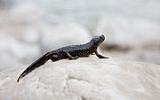
Alpine Newt
Encyclopedia
The Alpine Newt is a newt
of the Salamander
order Caudata (or Urodela) in the class of Amphibians.
 During the mating season early in the year, the males exhibit blue colouring on their backs; their flanks are stippled black and white, and on the belly are marked with a blue stripe. The shallow crest is alternately spotted yellow and black. The females, in water camouflage, are mottle grey-brown-green and have some weak spotting on the back. The belly side of both sexes is bright orange to vermillion and always unmarked. The biggest of the males can reach up to nine, and the females up to twelve centimeters in length. After the mating season, older specimens have a darker, almost black, velvety skin (land camouflage).
During the mating season early in the year, the males exhibit blue colouring on their backs; their flanks are stippled black and white, and on the belly are marked with a blue stripe. The shallow crest is alternately spotted yellow and black. The females, in water camouflage, are mottle grey-brown-green and have some weak spotting on the back. The belly side of both sexes is bright orange to vermillion and always unmarked. The biggest of the males can reach up to nine, and the females up to twelve centimeters in length. After the mating season, older specimens have a darker, almost black, velvety skin (land camouflage).
 Alpine newts were originally confined to Central Europe and mountainous Southern Europe, as well as an isolated area on the northern Iberian Peninsula
Alpine newts were originally confined to Central Europe and mountainous Southern Europe, as well as an isolated area on the northern Iberian Peninsula
. The species was introduced to southern England in the 1930s and several populations have become established as far north as Sunderland.
 The Alpine Newt was formerly placed within the genus Triturus
The Alpine Newt was formerly placed within the genus Triturus
. García-París et al. divided the genus Triturus, placing the Alpine Newt into its own genus Mesotriton. Later Mesotriton was postulated to be a junior synonym of Ichthyosaura. Ten subspecies of the Alpine Newt are recognized (some only with neotenic
forms).
Newt
A newt is an aquatic amphibian of the family Salamandridae, although not all aquatic salamanders are considered newts. Newts are classified in the subfamily Pleurodelinae of the family Salamandridae, and are found in North America, Europe and Asia...
of the Salamander
Salamander
Salamander is a common name of approximately 500 species of amphibians. They are typically characterized by a superficially lizard-like appearance, with their slender bodies, short noses, and long tails. All known fossils and extinct species fall under the order Caudata, while sometimes the extant...
order Caudata (or Urodela) in the class of Amphibians.
Description

Life and Habitat
Alpine newts typically inhabit forests with good access to water in hilly to mountainous regions. They are mostly absent in forest-poor areas. They populate well in thick deciduous forests, as well as parkland and natural gardens. Outside the spawning season, Alpine newts live terrestrially. During the day it stays in all kinds of undergrowth, but during the mating season in cool water (forest pools, artificial pools). After the adults come out of winter dormancy, they migrate to their spawning pools.Distribution

Iberian Peninsula
The Iberian Peninsula , sometimes called Iberia, is located in the extreme southwest of Europe and includes the modern-day sovereign states of Spain, Portugal and Andorra, as well as the British Overseas Territory of Gibraltar...
. The species was introduced to southern England in the 1930s and several populations have become established as far north as Sunderland.
Taxonomy

Triturus
Triturus is a genus of newt, commonly known as the crested or marbled newts, depending on the species. They are found across most of Europe, parts of Russia and the Middle East...
. García-París et al. divided the genus Triturus, placing the Alpine Newt into its own genus Mesotriton. Later Mesotriton was postulated to be a junior synonym of Ichthyosaura. Ten subspecies of the Alpine Newt are recognized (some only with neotenic
Neoteny
Neoteny , also called juvenilization , is one of the two ways by which paedomorphism can arise. Paedomorphism is the retention by adults of traits previously seen only in juveniles, and is a subject studied in the field of developmental biology. In neoteny, the physiological development of an...
forms).
- I. a. alpestris (Laurenti, 1768) Alpine Newt
- I. a. apuanus (Gray, 1850) Italian Alpine Newt
- I. a. cyreni (Mertens & Muller, 1940) Spanish Alpine Newt
- I. a. inexpectatus (Dubois & Breuil, 1983) Calabrian Alpine Newt
- I. a. lacusnigri (Dely, 1960) Yugoslavian Alpine Newt
- I. a. montenegrinus (Radovanovic, 1951) Montenegran Alpine Newt
- I. a. piperianus (Radovanovic, 1961)
- I. a. reiseri (Schreiber, 1912) Bosnian Alpine Newt
- I. a. serdarus (Radovanovic, 1961)
- I. a. veluchiensis (Wolterstorff, 1935) Greek Alpine Newt

